JKBOSE 10th Class Science Solutions Chapter 13 How Do Organisms Reproduce ?
JKBOSE 10th Class Science Solutions Chapter 13 How Do Organisms Reproduce ?
JKBOSE 10th Class Science Solutions Chapter 13 How Do Organisms Reproduce ?
Jammu & Kashmir State Board JKBOSE 10th Class Science Solutions
J&K class 10th Science How Do Organisms Reproduce ? Textbook Questions and Answers
BASIS AND BASICS
◆ The phenomenon of the formation of new individuals by the existing ones is called reproduction.
◆ Reproduction is a means of the perpetuation of the species and also a method of their multiplication.
◆ Reproduction, unlike other life processes, is not essential to maintain the life of an individual organism.
◆ Reproduction is formation of similar organisms with same body design, due to information of inheritance. (DNA or RNA).
◆ Reproduction involves creation of a DNA copy and additional cellular apparatus by the cell involved in the process.
◆ DNA copies formed are not identical and have some variations but if variations are drastic then new DNA copy cannot work.
◆ Niches are the well defined places of populations of organisms in any ecosystem.
◆ Each population has a particular niche in the ecosystem due to its ability to reproduce.
◆ Reproduction is linked to the stability of populations of species because of true copying of DNA during reproduction. It produces similar body designs in all organisms. Thus similar organisms can use their particular niche.
◆ Niches can drastically also alter due to temperature change on earth, water level change, or meteorite hits etc. Then variations help for the survival.
◆ Various organisms use different modes of reproduction depending on their body design.
◆ Two main broad categories of reproduction are (i) asexual reproduction and (ii) sexual reproduction.
◆ Asexual reproduction is production of young ones without formation and fusion of gametes.
◆ The common methods of asexual reproduction are:
(i) Fission (ii) Budding (iii) Spore formation (iv) Vegetative propagation (v) Regeneration (vi) Micro-propagation.
◆ In fission, many bacteria and protozoa simply divide into two or more daughter cells.
◆ Roots, stems and leaves of some plants develop into new plants through vegetative propagation.
◆ Types of asexual reproduction
1. Binary Fission. It is the simplest method of asexual reproduction generally found in unicellular organisms like Amoeba, Paramecium, Euglena etc. Binary means two and fission means breaking, thus this process results in the formation of two daughter cells.
2. Multiple fission. It is a type of asexual reproduction in which nucleus undergoes repeated division before the cytoplasm breaks to form a number of uninucleate daughter cells. Each cell thus formed grows into a new individual. Multiple fission occurs in Plasmodium.
3. Budding. It is a common method of reproduction in Sponges and Hydra. In this process, the new individual develops from a small outgrowth on the surface of parent.
4. Fragmentation. If a filament of spirogyra breaks upto fragments, each fragment grows into new indvidual.
5. Regeneration. It is a form of fission in which a parent individual divides into a 10 number of parts, each of which regenerates the structures to form a whole organism. It occurs in flatworm, ribbon worms and annelids.
6. Spore formation. An individual produces spores which during favourable conditions give rise to new individuals, e.g. Mucor.
7. Vegetative propagation. Vegetative propagation is defined as formation of two or more individuals from any vegetative part of plant. In this type of vegetative propagation new plants can be raised from roots or stems or leaves of a plant. It is a very rapid method. It is of two types.
A. Natural vegetative propagation
1. Natural vegetative propagation by roots in plants e.g. Radish, Dahlia.
2. Natural vegetative propagation by stem e.g., ginger, potato, onion.
3. Natural vegetative propagation by leaves e.g., Bryophyllum.
B. Artificial vegetative propagation.
1. Cutting
2. Grafting
3. Layering
4. Tissue Culture
◆ Sexual reproduction involves two individuals for the creation of a new individual.
◆ Sexual reproduction typically involves :
- gametogenesis, that is, formation of special sex cells, the gametes, by male and female individuals of a species.
- fertilization, that is, fusion of a male gemete, the spermatozoan, and a female gamete, the ovum, to form a zygote ; and
- development, that is, formation of a new individual by repeated mitotic divisions of the zygote.
◆ Fertilization may be external (frog and fishes) or internal (human beings).
◆ Sexual reproduction is highly evolved.
◆ Importance of Sexual reproduction
- The sexual mode of reproduction incorporates process of combining DNA from two different individuals during reproduction.
- Sexual reproduction promotes diversity of characters in the offspring.
- It results in new combinations of genes brought together in the gamete and this reshuffling increases genetic variation.
- It introduces variations for the better survival of species.
- When variations are to combine from two organisms it needs sexual reproduction.
- To maintain the balance in chromosome number, sexual reproduction introduces special cells (gametes) with half the chromosome numbers.
- It plays an important role in origin of new species.
Sexual reproduction in flowering plants
The sexual reproduction in plants takes place in the following steps: Most of the plants are bisexual.
- The reproductive parts of angiosperms are located in the flower.
- Stamens and carpels are the reproductive parts of a flower, which contain the germ cells. They are essential parts of flower.
- The male organ of a flower called ‘stamen’ makes the male gametes, which are present in pollen grains of the plant.
- The female organ of a flower called ‘carpel’ or ‘pistil’ makes the female gametes, which are present in ovules of the plant.
- The male gametes present in pollen grains fertilise the female gametes present in ovules of the plants.
- The fertilised ovules grow and become flowering plants.
- The seeds produce new plants.
- Ripened ovary is called fruit.
◆ Parts of a flower. A flower consists of the following parts :
(i) Pedicel (ii) Thalamus (iii) Calyx (iv) Corolla (v) Androecium (vi) Gynaecium.
◆ Calyx and corolla form the accessory whorls while androecium (male part) and gynaecium (female part) form the reproductive whorls.
◆ Pollination is the transference of pollen grains from the anthers of a flower to the stigma of the same flower or of another flower of the same species.
◆ Pollination is of two kinds i.e. self-pollination and cross-pollination.
◆ Fertilization is the process of fusion of the male gamete with an egg or oosphere.
◆ Double fertilisation in plants.
- Soon after pollination the pollen grains start germinating and form a pollen tube. The pollen tube grows within the style till it reaches the ovary.
- On reaching the ovary it enters the ovule through an opening called micropyle. In the meantime, two male gametes are formed in the pollen tube. One of the male gametes fuses with the eggs, the process called syngamy. The product formed is termed as zygote.
- The other male gamete fuses with the two polar nuclei one from each end of embryo albe sac to form endosperm nucleus. This process is called triple fusion. In this process three nuclei, two polar nuclei and one male gamete is involved, so it is called triple fusion.
- Thus, inside each embryo sac two fusions, i.e. syngamy and triple fusion takes place. This mechanism of two fusions occurring in an embryonal sac is called double-fertilisation. After fertilisation, the ovule develops into seed and the ovary develops into a fruit.
◆ Pollen grain germinates on stigma and the pollen tube penetrates the ovule.
◆ One male gamete fuses with the egg to form the zygote (syngamy) and the other fuses with the two polar nuclei or the secondary nucleus in the middle to form the triploid primary endosperm nucleus. This is called double fertilization and is unique to the flowering plants.
◆ After fertilization, the ovule develops into a seed. The zygote forms the embryo, the primary endosperm nucleus gives rise to the endosperm and the integuments contribute towards the formation of seed of seed coats. The food is stored in the cotyledons or the endosperm.
◆ After fertilization most other floral parts dry and fall off while the ovary enlarges to form fruit with ovules becoming seeds.
IMPORTANT TERMS AND FACTS TO MEMORISE
⇒ Reproduction. It is the process of producing new organisms by existing organisms of a species.
⇒ Sexual reproduction. The production of offsprings by the fusion of male and female gametes is called as sexual reproduction.
⇒ Asexual reproduction. The production of progeny without the fusion of male and female gametes is called as asexual reproduction.
⇒ Fission. The division of an organism into two or more individuals is called as fission.
⇒ Budding. The process of development of an outgrowth due to repeated cell division at one specific site which grows into tiny individual is called budding.
⇒ Vegetative propagation. The process of development of new individual from any part of the body is called vegetative propagation.
⇒ Grafting. The technique of joining the different parts of two different plants to grow into one plant.
⇒ Unisexual. When the male and female are separate individuals, they are called unisexual.
⇒ Bisexual/Hermaphrodite. The organisms having male and female in single individual are called bisexual/hermaphrodite.
⇒ Scion. A stem piece of good quality plant is grafted to grow into a new plant is called scion.
⇒ Layering. The production of new plant by covering the leaned branches of a plant under soil.
⇒ Pollination. The transfer of pollen from anther to stigma.
⇒ Fertilization. The fusion of male and female gametes is called fertilization.
⇒ Syngamy. The fusion of male gamete with female gamete is called syngamy.
⇒ Double fertilization. When the fertilization occurs two times (with ovum and polar cell) in angiosperms the process is called double fertilization.
⇒ Puberty. The process of becoming sexually mature.
⇒ Ovulation. The release of ovum from ovary.
⇒ Implantation. The fixation of embryo in the uterus is called implantation.
⇒ Placenta. It is the connection between mother and embryo.
⇒ Parturition. The process of giving birth to foetus is called parturition.
TEXT BOOK QUESTIONS (SOLVED)
Q. 1. What is the importance of DNA copying in reproduction ?
Ans. 1. DNA copying is called DNA replication. In this process one copy each of replicated DNA will be passed on two daughter cells. Each cell formed will have its own cellular apparatus to control the activities of the daughter cells.
2. It maintains the body designs and features in different generations of the species.
3. Variations may be introduced during copying of DNA. This inbuilt tendency for variation during reproduction form the basis of evolution.
Q. 2. Why is variation beneficial to the species but not necessarily for the individuals ?
Ans. Variations present in some populations would enable them to survive. In case of changing environmental condition such as global warming. Thus it is useful for survival of species over time.
Q. 3. How does binary fission differ from multiple fission?
Ans. Differences between binary fission and multiple fission
| Binary fission | Multiple fission |
| 1. Parent divides into two daughters. | 1. Parent divides into many daughters. |
| 2. It takes place during favourable conditions. | 2. It takes place during unfavourable conditions. |
| 3. Residual cytoplasm is left. | 3. Nothing is left with parent. |
| 4. Cytoplasm divides after every nuclear division. | 4. Cytoplasm does not divide after every nuclear division. |
Q. 4. How will an organism be benefited if it reproduces by spores ?
Ans. 1. Spores are covered by thick walls, that protect them until they come into contact with another substratum on which they can grow.
2. They are produced in large numbers.
Q. 5. Can you think of reasons why more complex organisms cannot give rise to new individuals through regeneration ?
Ans. 1. Regeneration is not reproduction because most organism would not depend on being cut up.
2. It is not certain that cut up portion will be able to survive and give rise to a new individual.
Q. 6. Why is vegetative propagation practised for growing some types of plants ?
Ans. Advantages of vegetative propagation.
- It is usually a means of propagating such plants which do not produce viable seeds.
- It is rapid method of producing young ones.
- It helps in retaining useful characters from generation to generation.
Q. 7. Why is DNA copying an essential part of the process of reproduction ?
Ans. 1. DNA copying provides cellular apparatus in the daughter cells.
2. DNA in daughter cells will be able to control the functioning of daughter cells.
3. DNA copies will retain the traits.
Q. 8. How is process of pollination different from fertilisation ?
Ans. Differences between pollination and fertilization
| Pollination | Fertilization |
| 1. It is the transference of pollen grains from anther to stigma. | 1. It is fusion of a male and female gametes. |
| 2. An external agent is required like wind, water and animal. | 2. It does not require any external agent. |
| 3. Pollination generally leads to fertilization. | 3. Fertilization leads to fruit and seed formation. |
Q. 9. What is the role of seminal vesicles and prostate gland ?
Ans. Role of seminal vesicles. These glands secrete viscous secretions, which contain fructose and prostaglandins. The fructose is the source of energy for sperms and prostaglandins stimulate uterine contraction and thus may help the sperm to move towards the female’s oviduct.
Role of prostate gland. It secretes an alkaline milky fluid that aid in sperm motality. The fluid contains small amount of citric acid, some lipids and a few enzymes. It also contains bicarbonate ions which give the semen its alkaline pH.
Q. 10. What are the changes seen in girls at the time of puberty ?
Ans. Changes at the time of puberty. These changes occur under the influence of hormones FSH (Follicle stimulating hormone) and estrogen.
1. Growth of breast and external genitalia.
2. Darkening of nipple skin.
3. Broadening of pelvis.
4. Growth of pubic and axillary hair.
5. Increase in subcutaneous fat.
6. Initiation of menstruation and ovulation.
Q. 11. How does embryo get nourishment inside the mother’s body ?
Ans. Embryo gets nourishment through placenta. Placenta is a disc embedded in the wall of uterus. It contains villi on the embryo side of tissue. On the mother side are blood spaces which surround villi. Placenta serves to bring the foetal and maternal blood close enough to permit exchange of materials between the two.
Q. 12. If a woman is using a copper-T, will it help her in protecting sexually transmitted diseases ?
Ans. Copper-T prevents fertilization but the chances of infection persists. Thus it will not help her in protecting from sexually transmitted diseases.
TEXT BOOK EXERCISES (SOLVED)
Q. 1. Asexual reproduction takes place through budding in :
(a) Amoeba
(b) Yeast
(c) Plasmodium
(d) Leishmania.
Ans. (b) Yeast.
Q. 2. Which of the following is not a part of the female reproductive system in human beings ?
(a) Ovary
(b) Uterus
(c) Vas deferens
(d) Fallopian tube.
Ans. (c) Vas deferens.
Q. 3. The anther contains :
(a) Sepals
(b) Ovules
(c) Carpel
(d) Pollen grains.
Ans. (d) Pollen grains.
Q. 4. What are advantages of sexual reproduction over asexual reproduction ?
Ans. Advantages of sexual reproduction
Sexual reproduction has a dual significance for the species.
1. It results in multiplication and perpetuation of the species.
2. It contributes to evolution of the species by introducing variation in a population much more rapidly than asexual reproduction.
Q. 5. What are the functions performed by the testis in human beings ?
Ans. Functions of testis
1. Produce male gametes, called sperms.
2. Leydig’s cells secrete male sex hormone namely testosterone into blood.
Q. 6. Why does menstruation occur ?
Ans. During menstruation broken down endometrium is passed out as menstrual flow along with unfertilized egg (ovum).
Q. 7. Draw a labelled diagram of Longitudinal section of flower.
Ans. Longitudinal section of flower.
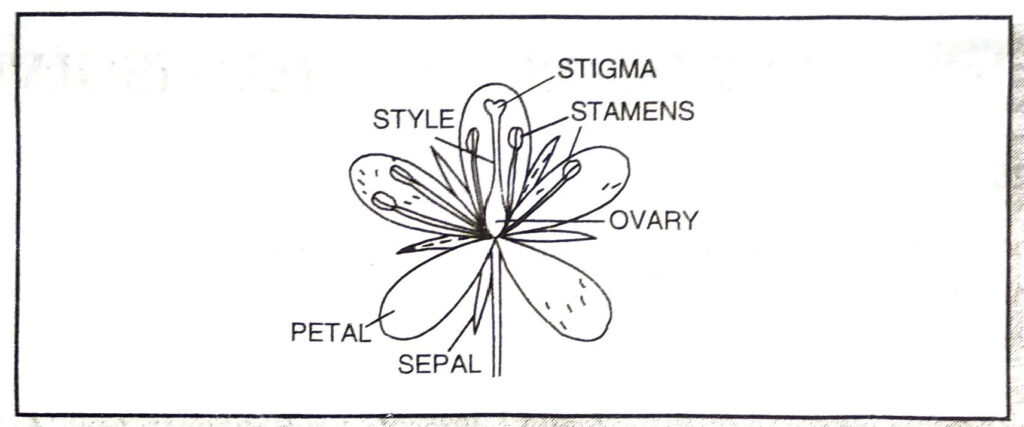
Q. 8. What are different methods of contraception ?
Ans. Methods of contraception.
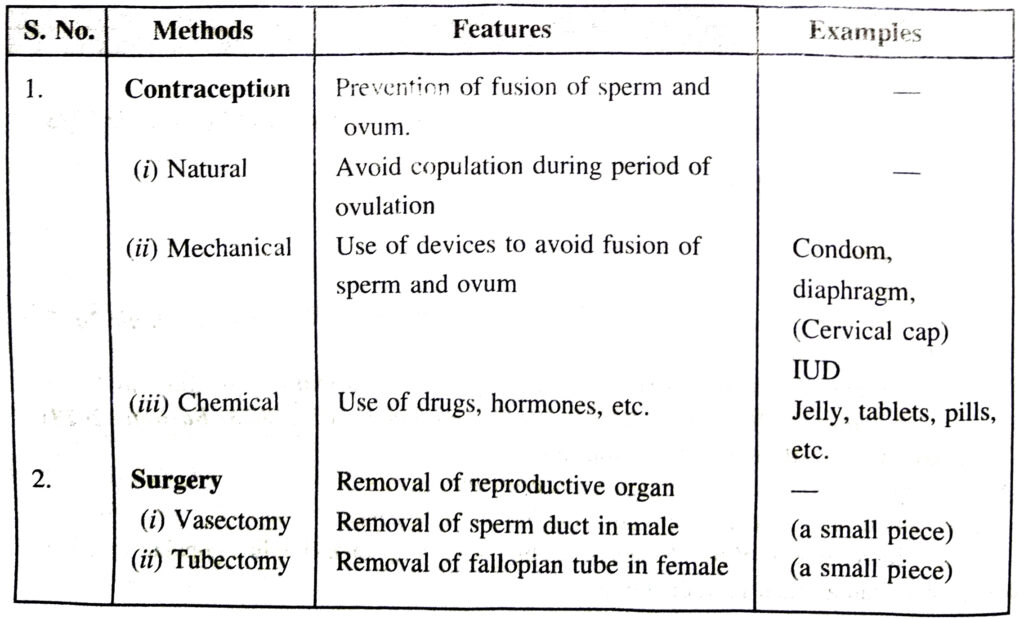
Q. 9. How are modes of reproduction different in unicellular and multicellular organisms?
Ans. Unicellular organisms mostly reproduce by asexual methods except for a few such as Paramecium, Eimeria, these organisms reproduce by sexual methods also. The multicellular organisms have more complex body. They reproduce both by asexual and sexual methods. But sexual reproduction is the more common method.
Q. 10. How does reproduction help in providing stability to populations of species ?
Ans. Reproduction is the process by which organisms increase their populations. The rates of birth and deaths in a given population determine its size.
ADDITIONAL IMPORTANT QUESTIONS
LONG ANSWER TYPE QUESTIONS
Q. 1. What is the basic need of reproduction ? How does variation arise ?
Ans. A basic event in reproduction is the creation of a DNA copy. DNA of nucleus of cell is the store house of information for making proteins and directing other biochemical reactions in the cell. The different proteins will eventually lead to a different setups, shapes, working etc of body. Cells use chemical reaction to build copies of their DNA. This creates two copies of the DNA in a reproducing cell and they will need to be separated from each other.
DNA copying (DNA replication) is accompanied by the creation of an additional cellular apparatus and then the DNA copies separate, each with its own cellular apparatus. Effectively, a cell divides to give rise to two cells.
Origin of Variation. The two cells formed are similar, but unlikely to be absolutely identical. No bio-chemical reaction is absolutely reliable. Therefore, it is only to be expected that the process of copying the DNA will have some variation each time. As a result, the DNA copies generated will be similar, but may not be identical to the original. Some of these variations might be so drastic that the new DNA copy cannot work with the cellular apparatus it inherits. This inbuilt tendency for variation during reproduction is the basis for evolution.
Q. 2. What are different types of asexual reproductions.
Or
Explain fission and fragmentation.
Ans. Types of asexual Reproduction.
1. Binary fission 2. Multiple fission 3. Budding 4. Fragmentation 5. Regeneration 6. Spore formation 7. Vegetative propagation Detail-Refer to Basis and Basics.
Q. 3. Explain-post fertilization changes in plants.
Ans. Post fertilization changes in a plant:
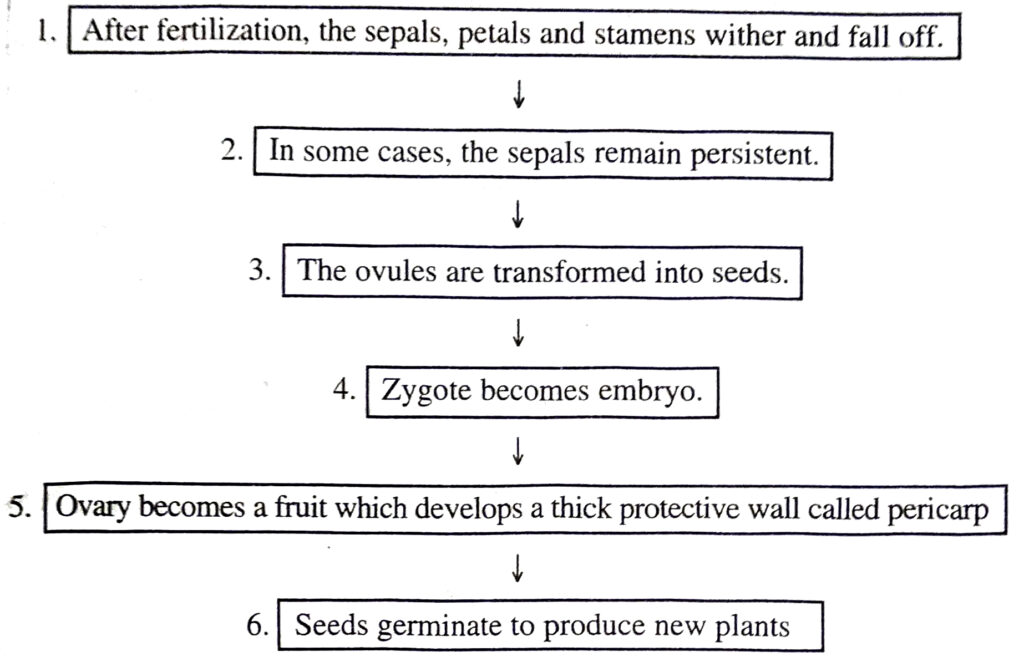
Q. 4. Describe the structure of a flower.
Or
With the help of a well labelled diagram, describe the parts of a flower.
Ans. 1. Pedicel. It is stalk of the flower which raises it in the air to expose the flower to the pollinating agencies.
2. Thalamus. The swollen or broad base or flat apex of pedicel that bears the floral leaves is called thalamus or torus.
3. Calyx or Sepals. The sepals are the outermost whorl of flower. They are collectively known as calyx.
4. Corolla or Petals. It is the second whorl of flower. They are brightly coloured leaf-like flattened structures.
Petals may also be scented and have nectar glands at the base to attract pollinating agents i.e. insects.
5. Stamens or Androecium. Stamens are the male reproductive parts of the flower. Each stamen consists of a slender stalk filament and a knob-like terminal anther. Each anther has two anther lobes. Each anther lobe has two pollen chambers containing pollen grains.
6. Carpels or Gynaecium. The carpels represent the female parts of a flower. They are present on the central region of thalamus. They may be free or united. The free occurring unit of gynaecium is called pistil. Each pistil consists of three parts ovary, style and stigma.
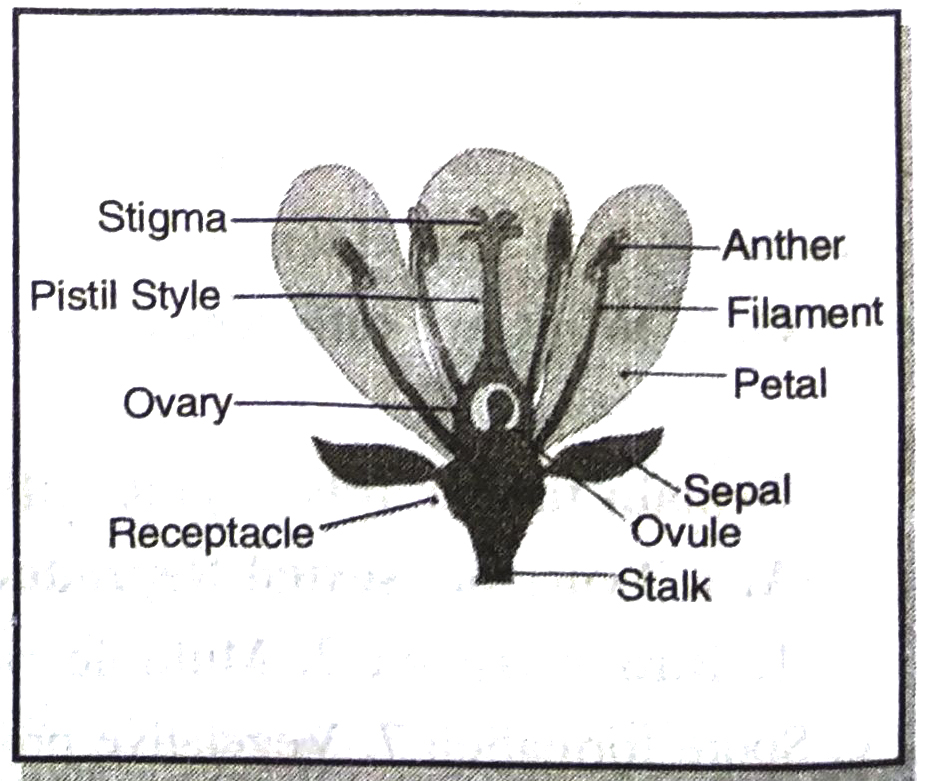
Q. 5. With the help of simple sketches show the structure of seed and its germination.
Ans. Structure of Seed
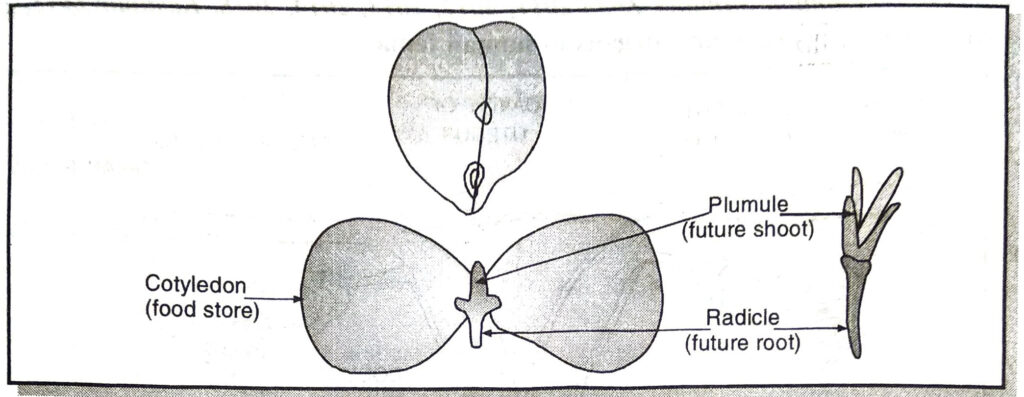
Q. 6. Draw a well labelled diagram of male reproductive system of man.
Ans. Male reproductive system
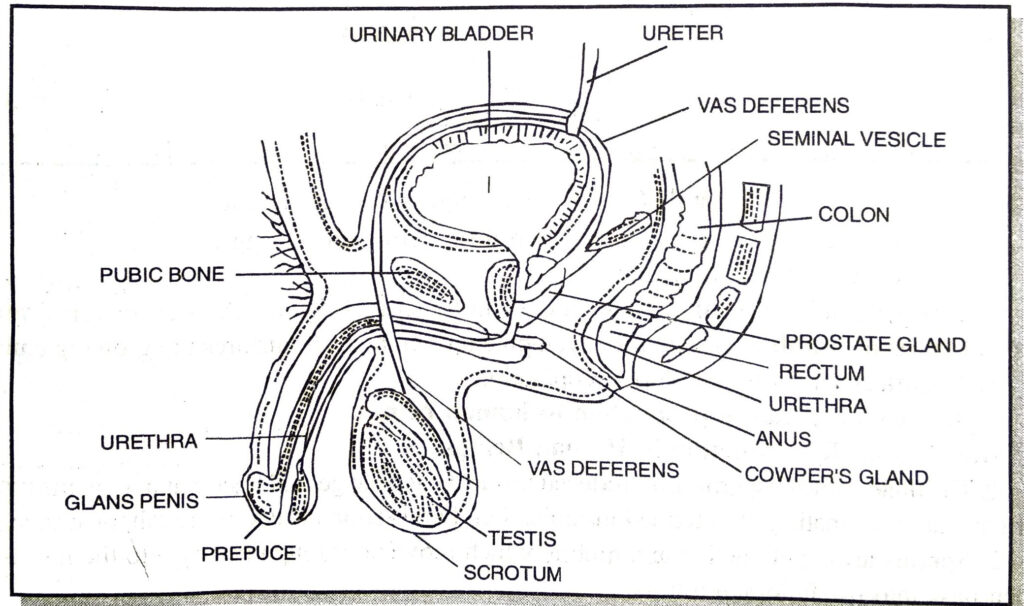
Male reproductive system of human
1. Pair of testes. These are primary sex organs. They produce male gametes, sperms. They also secrete hormones.
2. Pair of vasa deferentia (Sing vas deferens). These are ducts which transfer sperms.
3. Reproductive glands include pair of seminal vesicles, single prostate gland and pair of cowper’s gland. They form semen along with sperm.
4. Copulatory organ (penis). It is involved in copulation.
Q. 7. Draw a well labelled diagram of reproductive organs of female human and explain human female reproductive system.
Ans. Female reproductive organs of human female
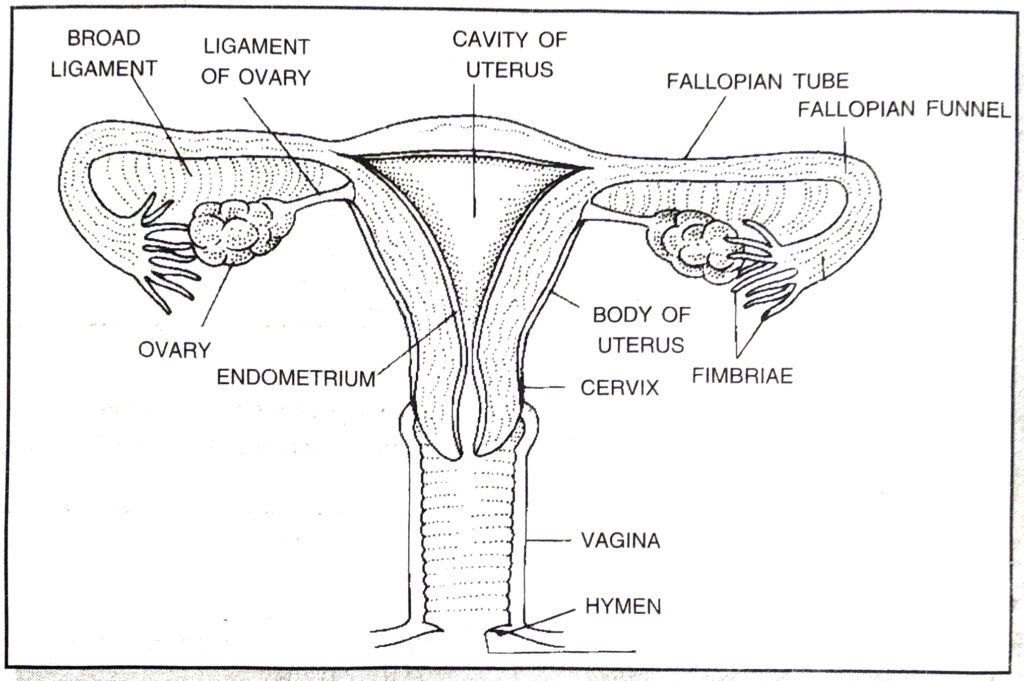
1. Ovaries are primary sex organs which form germ cells or eggs.
2. Ovaries also secrete hormone.
3. A pair of fallopian tubes conduct eggs into uterus. It is also the site for fertilization.
4. Uterus or womb is the site for development of embryo. It nurtures the growing embryo.
5. Vagina receives semen during copulation.
Q. 8. Explain sexual reproduction in human beings.
Ans. Sexual Reproduction in Human Beings.
1. The male gamete (sperm) is introduced inside the female genital tract (vagina) by the process of copulation or mating. It is termed insemination. Fertilisation occurs in the fallopian tube.
2. Sperms are highly active and mobile which move up through cervix into the uterus and then pass into the fallopian tubes.
3. Fallopian tube is the site of fertilization. Only one sperm fertilises the ovum to form a zygote.
4. Fertilisation occurs only if copulation takes place during the ovulatory period of menstruation cycle.
5. The embryonic development of the zygote starts immediately in the fallopian tube and pregnancy starts while menstruation stops.
6. The embryo m moves down to reach the uterus. The embedding of embryo in the thick inner lining of the uterus is called implantation.
7. Then, a special tissue develops between the uterine wall and the embryo (foetus) called placenta, where the exchange of nutrients, oxygen and waste products take place.
8. The time period from the development of foetus inside the uterus till birth is called gestation.
9. The act of giving birth to the fully developed foetus at the end of gestation period is termed as parturition.
10. The development of the child inside the mother’s body takes approximately 280 days.
Q. 9. Describe the various physical and chemical methods of birth control.
Ans. The various methods of birth control are :
1. Physical barriers. Use of contraceptives. It means prevention of conception. Following contraceptives are popular :
(a) Diaphragm. The vaginal diaphragm is a rubber cup stretched over a collapsible metal spring coil. It is designed to fit over the cervix, i.e. the mouth of uterus which prevents fertility or conception.
(b) Condom. The condom is a sheath of rubber which fits on the erect penis. It is put on the penis before it is introduced in the vagina during intercourse.
(c) Jellies, creams and foams. A number of different spermicidal jellies, creams and foams are available for use as contraceptive agents. These jellies, creams and foams are inserted into vagina five to fifteen minutes before the ejaculation takes place.
(d) Introduction of copper ‘T’ or loop in female uterus prevents the entry of sperms in uterus.
2. Chemical Methods. Oral Contraceptives. These are popularly known as “pills” and are combinations of synthetic sex hormones which suppress the production of ovum. These pills alter the ovulation cycle. ‘Mala’ and ‘Saheli’ are the two common pills.
Q. 10. Briefly explain surgical and other methods of birth control.
Ans. 1. Surgical methods. Sterilization. It is surgical technique by which the passage of sperms or ovum is discontinued. Both men and women can be sterilized without losing their ability to function sexually.
(a) Vasectomy. In men the sterilization procedure is called vasectomy.
(b) Tubectomy. In woman part of fallopian tube is cut and tied off.
2. Medical termination of pregnancy (MTP). It is the cessation of pregnancy by surgery, suction or by other means.
3. Other measures.
(a) Abstinence. Abstaining from intercourse.
(b) Coitus interruptus. It involves the withdrawal of penis from the vagina just before ejaculation occurs.
(c) Zero ‘0’ method. It is a natural, effective and practical method where the woman has to find out herself the fertile and infertile period, by keeping a close watch on uterine discharge. The safest period to avoid pregnancy is from the beginning of mucus discharge to the next four days, after the discharge has stopped.
SHORT ANSWER TYPE QUESTIONS
Q. 1. What is reproduction? What are its basic types ?
Ans. Reproduction. All organisms born on this earth show characteristic life cycle, involving birth, growth, maturation, reproduction and death. Reproduction is one of the most important processes by which continuation of the species from one generation to another generation can take place. Older and aged organisms are replaced by new and younger organisms by reproduction. There are two basic types of reproduction.
A. Asexual reproduction B. Sexual reproduction
Q. 2. Define asexual and sexual reproduction.
Ans. Asexual Reproduction. It is a type of multiplication in which a young one is formed from a specialised or unspecialised part of a parent without the formation and fusion of sex cells, gametes.
Sexual Reproduction. It is a type of reproduction which takes place by the formation and fusion of gametes. It involves two major processes :
(a) Meiosis (reductional division) by which diploid sporophytic cells give rise to haploid gametes, and
(b) Fertilization, which reconstitutes the sporophytic diploid generation through gametic fusion.
Q. 3. Differentiate asexual and sexual reproduction.
Ans. Differences between asexual and sexual forms of reproduction
| Asexual Reproduction | Sexual Reproduction |
| 1. The process involves only one cell or one parent. | 1. This process involves two cells or gametes belonging to either the same or different parents. |
| 2. The whole body of the parent may act as reproductive unit or it can be a single cell or a bud. | 2. The reproductive unit is called gamete which is unicellular and haploid. |
| 3. Only mitotic division takes place. | 3. Meiosis and fertilization are essential events. |
| 4. No formation of sex organs. | 4. Formation of sex organs is essential. |
Q. 4. Describe asexual reproduction in Amoeba.
Or
Explain the term fission as used in relation to reproduction.
Ans. Binary fission in Amoeba. It is normal method of reproduction in Amoeba. It occurs under favourable conditions. The animal grows until it attains the maximum size and then divides by binary fission in every three or four days. The fission is completed in 15 to 20 minutes.
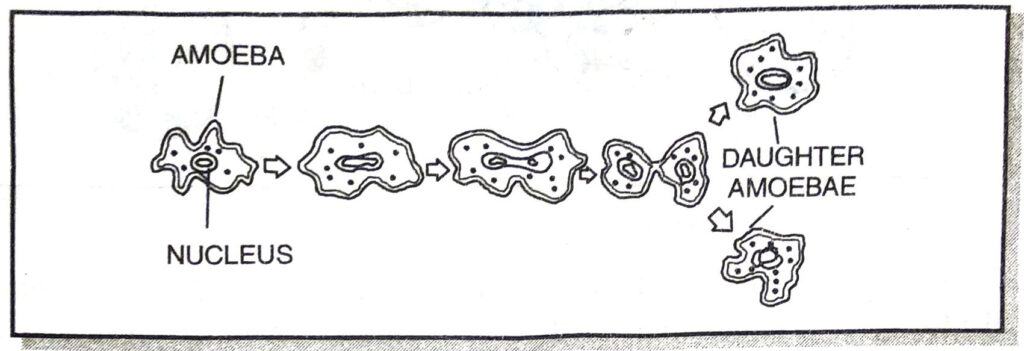
Multiple fusion in Amoeba
Multiple fission inside the cyst has been described but not established. It has been suggested that sometimes, inside the cyst, the nucleus divides and surrounds itself with cytoplasm to form several small amoebulae. At the return of favourable conditions or on finding a favourable substrate, the cyst absorbs water and its walls burst. The amoebulae escape and soon each one grows into new amoeba.
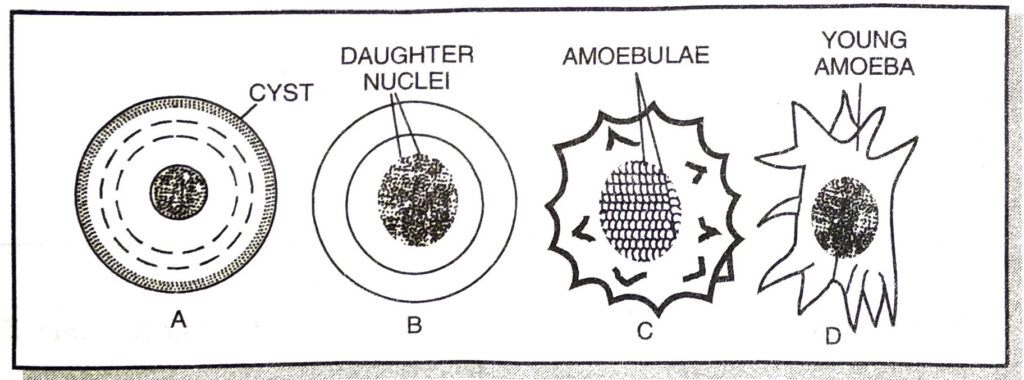
Q. 5. Explain various steps of budding in yeast.
Ans. Budding in yeast. Most of the common yeasts reproduce by budding. The process of budding occurs under normal conditions, when the yeast cells are growing in sugar solution. Saccharomyces usually reproduce by budding. In the process, each cell gives rise to one or more tiny outgrowths which gradually increase in size as large as the mother cell itself. Ultimately, it is cut off from the mother cells by a constriction at the base and can lead a separate existence. The nucleus divides amitotically during budding and one daughter nucleus passes in the bud and the other remains in the mother cell. The nuclear membrane persists throughout the nuclear division. The budding may be repeated by the daughter cell while still attached to the parent cell, resulting in the formation of one or more chains and even subchains, called pseudomycelium. The cells ultimately become separated from one another and lead independent life.
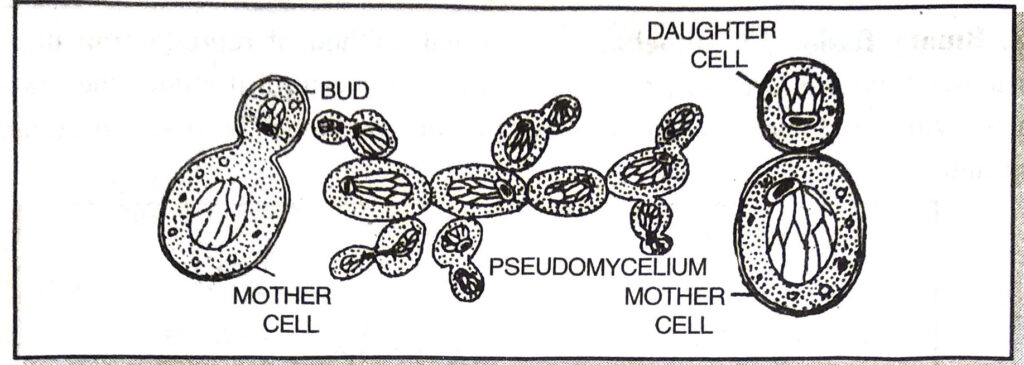
Q. 6. Explain various steps of budding in Hydra.
Ans. Budding. It is a common method of reproduction in Sponges and Hydra. In this process, the new individual develops from a small outgrowth on the surface of parent. The exogenous bud gets its nourishment from the parent till it gets the maturity. Then it breaks off from the parent body and develops into new individual. Sometimes, the buds do not separate off and form a chain of buds.
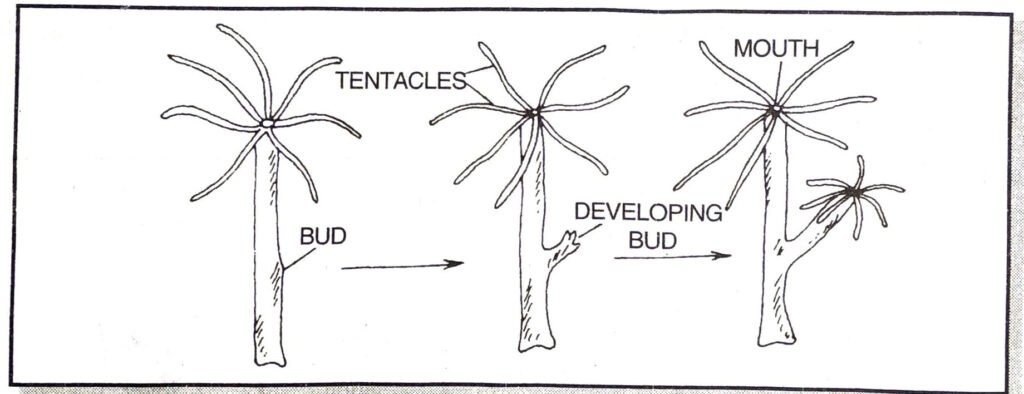
Q. 7. Discuss spore formation in fungi.
Or
Illustrate spore formation in Rhizopus with a diagram.
Or
Write the benefit of spore reproduction.
Ans. Spore formation. The spores in fungi vary in shape. Spores are usually unicellular, thick walled, spherical. The thick walls provide protection till these come in contact with other surface and can begin to grow. Sometimes the spores may be multicellular also. Sometimes the spores are produced endogenously in special sac-like asexual reproductive bodies called sporangia. Spores in such cases are called sporangiospores. Spores on falling on ground or substratum grow new hypha, e.g., Rhizopus, Mucor and Penicillium.
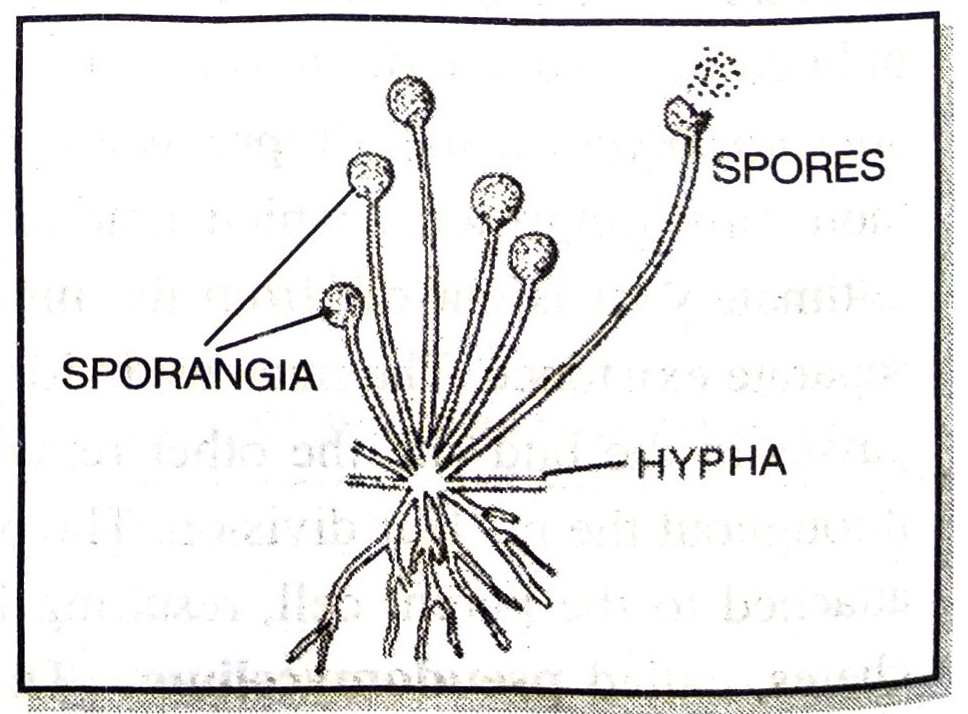
Benefits 1. It is a fast method of reproduction.
2. Very large number of spores produced ensure survival of organism.
Q. 8. What is regeneration ?
Or
Explain the term regeneration as used in relation to reproduction.
Ans. Regeneration. The process of repair, replacement or revival of damaged or severed body parts or reconstruction of the whole body from a small fragment of it during the post-embryonic period of a multicellular organism is termed regeneration. It is a morphogenetic mechanism.
Q. 9. Describe regeneration in Planaria.
Or
Describe process of regeneration with the help of a suitable diagram.
Ans. Regeneration in Planaria.
When the anterior end of Planaria is cut along the length into two more parts, each part develops into a new head, resulting in a many headed planaria.
If the body is cut into three, four or more pieces, each piece regenerates the missing parts. A noteworthy observation in this case is that a piece from the middle always regenerates a head towards its anterior side and tail towards its posterior side. In other words, each piece maintains its original polarity.
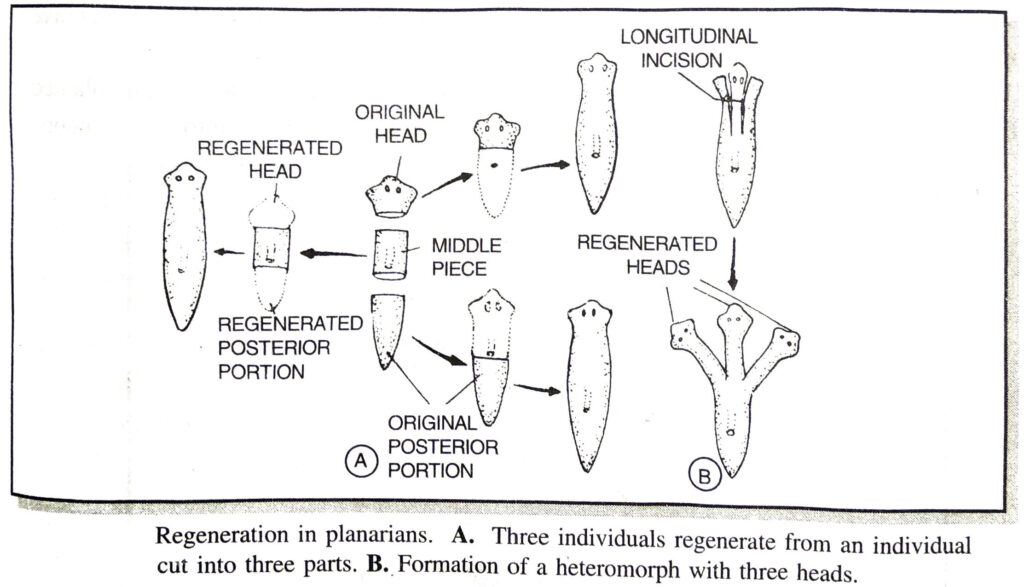
Q. 10. What is vegetative propagation ?
Ans. Vegetative Propagation. Vegetative propagation is defined as formation of two or more individuals from any vegetative part of plant. In this type of vegetative propagation new plants can be raised from roots or stems or leaves of a plant. It is a very rapid method. It is of two types.
A. Natural vegetative propagation
B. Artificial vegetative propagation.
Q. 11. Explain natural vegetative propagation by roots in plants.
Ans. A number of herbaceous and woody perennial plants propagate vegetatively in natureThe common structures that take part in natural vegetative propagation are roots, stems leaves and buds.
Vegetative Propagation by Roots. Roots of some plants like radish, carrot, asparagus, tapioca, Dahlia and sweet potato etc. are tuberous and store abundant food material.
These roots when planted in specially prepared beds (soil), develop adventitious buds which grow into leafy shoots called “slips”. As the root tubers in sweet potato store large amounts of food, each produces several “slips” The young “slips” are detached from the parent plant and grown separately.
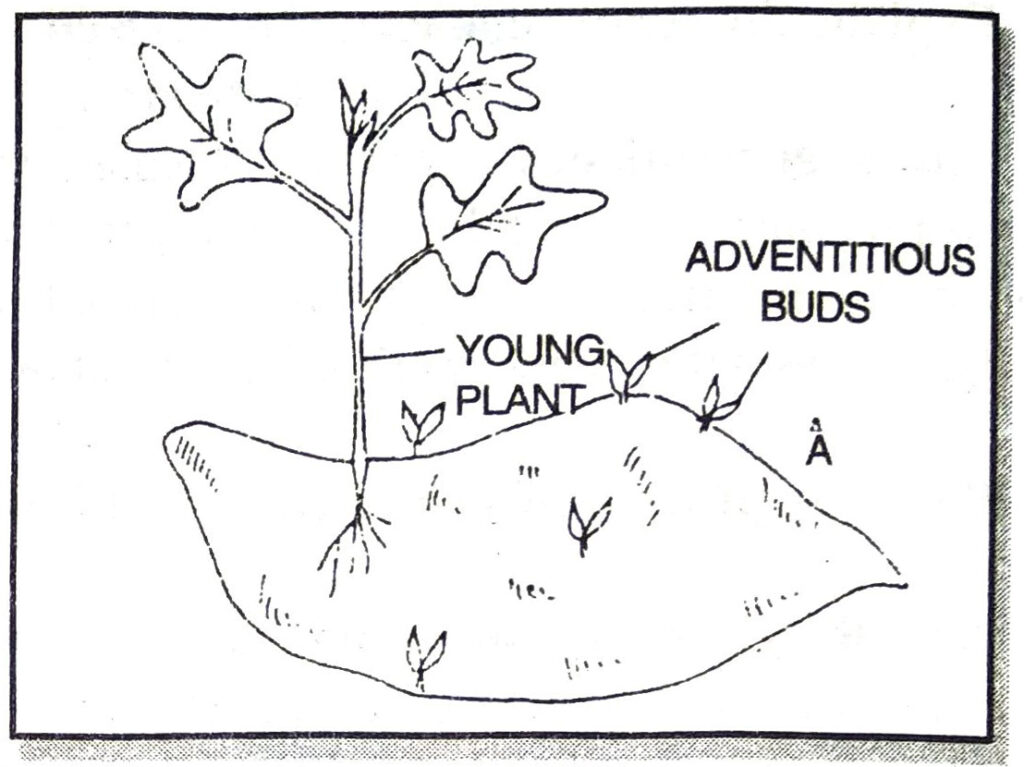
Q. 12. Briefly explain vegetative propagation by stems.
Ans. Vegetative propagative by stems
All underground stems even some aerial stems help in vegetative propagation. Aerial stems of sugarcane, Ipomoea, grape vine and cacti are also used for vegetative propagation.
In sugarcane, portions of the stem bearing one or more nodes and buds are cut and planted in the soil. Adventitious roots develop from the nodes and the buds grow into aerial shoots.
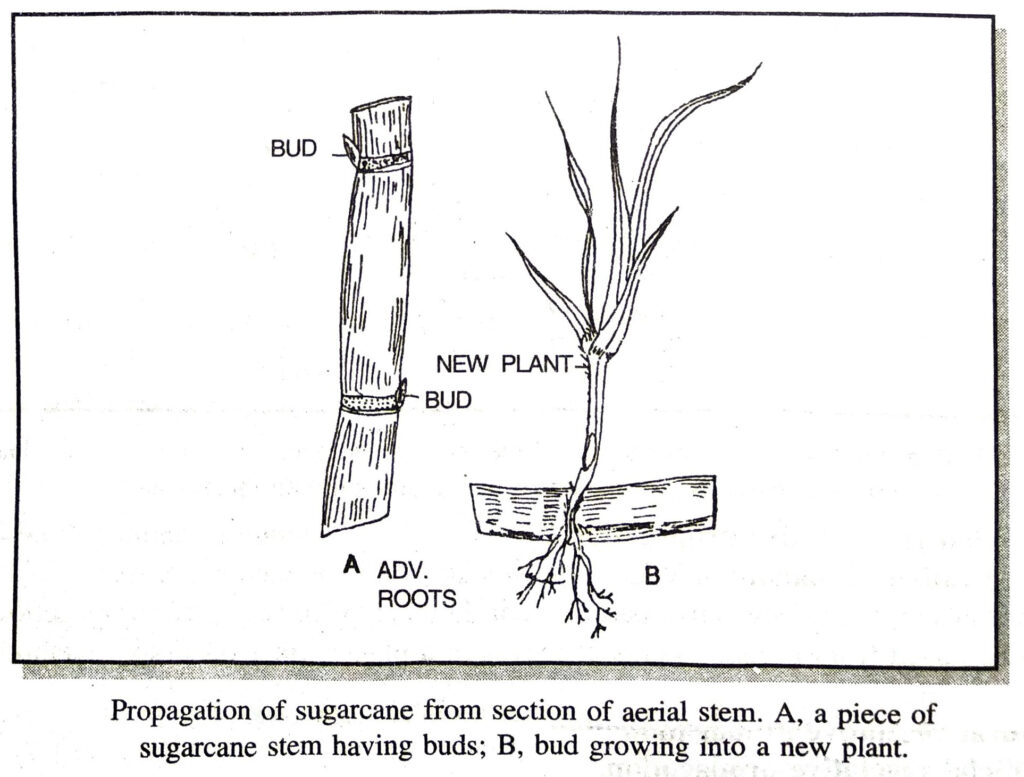
Q. 13. Give a brief account of vegetative propagation in leaves.
Or
Illustrate the following with the help of suitable diagram :
Leaf of Bryophyllum with buds.
Ans. Vegetative Propagation by Leaves. Under suitable conditions new plants can develop from the leaves.
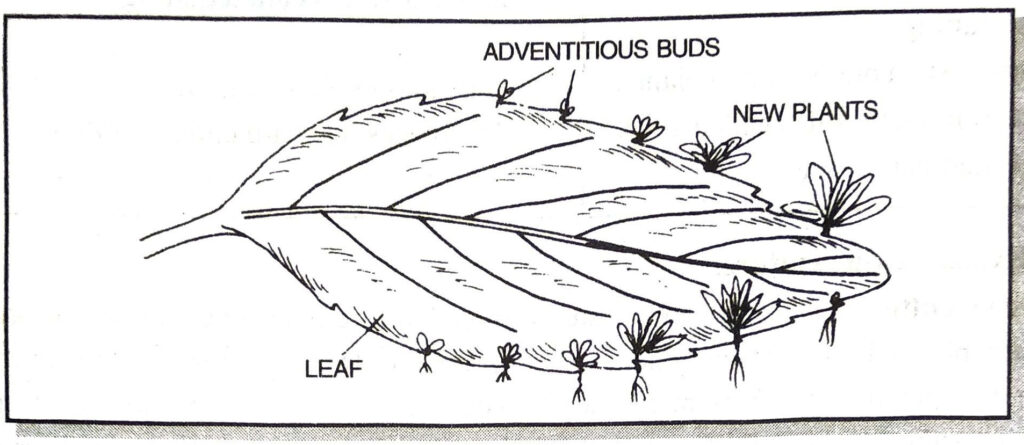
In Bryophyllum, leaf helps in vegetative propagation. In the leaf there are notches, where meristem is present. When leaf comes in contact with soil, this meristem produces a new plant. Adventitious buds are formed in Begonia and Lilium on leaves which too help in vegetative propagation.
Q. 14. Explain briefly types of vegetative propagation in plants.
Ans. (A) Natural vegetative propagation
1. Vegetative propagation by stems. e.g. Grasses, Turmeric, Onion, Potato, Gladiolus.
2. Vegetative propagation by roots. e.g. Tuberous roots of Sweet potato, Tapioca, Dahila and Yams (Dioscorea).
3. Vegetative propagation from reproductive organs. Flower buds of century plant (Agave sp.) develop into bulbils.
4. Vegetative propagation from leaves e.g., Bryophyllum.
B. Artifical vegetative propagation
1. Cutting, grafting and layering are the common methods used for propagation of sugarcane, roses, grapes for agriculture.
2. Such methods also make possible for propagation of plants such as banana, orange, rose and jasmine.
Q. 15. What is artificial vegetative propagation ?
Ans. Artificial vegetative Propagation. Vegetative propagation is very rapid method of multiplication and is used commercially because the new individuals formed maintain the desirable characters of parents. Gardeners and horticulturists have employed various methods of vegetative propagation for getting many ornamental and food plants.
Q. 16. Differentiate grafting and cutting.
Ans. Differences between grafting and cutting
| Grafting | Cutting |
| 1. The process of fixing the stem piece on another stem fixed to the soil is called grafting. | 1. The use of piece or cutting and placing it in moist soil is called cutting. |
| 2. It involves stem pieces of two plants. | 2. Only single plant is used. |
| 3. The stem fixed to soil is called stock and grafted part is scion. |
3. The pieces used are called cutting.
|
Q. 17. Explain tissue culture.
Ans. Tissue culture. In this method, tissue or organ culture is utilized. Tissue or organ is grown on suitable medium containing hormones. Tissue proliferates to form callus. From this callus arise new plantlets. Each plantlet when transferred to pot or soil produces new plant. Thus by this method, an indefinite number of plants can be raised from a small mass of parental tissue. This technique is commonly used for ornamental plants.
Q. 18. Write merits of vegetative propagation.
Or
Why is vegetative propagation practised for growing some types of plants?
Ans. Merits of vegetative propagation
Vegetative propagation has outstanding advantages. Some of these are as follows:
1. Plants produced by vegetative propagation are genetically similar and constitute a uniform population called as clone.
2. Some fruit trees like banana, pine-apple do not produce viable seeds so these are propagated by only vegetative methods.
3. It is more rapid and easier method of propagation.
4. Good characters are preserved by vegetative propagation.
5. Most of the ornamental plants are propagated by vegetative propagation.
Q. 19. Write demerits of vegetative propagation.
Ans. Demerits of vegetative propagation
1. New varieties cannot be produced by vegetative propagation.
2. Quality of fruits cannot be changed since there is no sexual fusion, no meiosis and no recombination of characters occur.
3. In weed plant, it is harmful as there occurs wide spread of weed.
4. Disease contacted by a parent plant propagates in all the daughter plants.
5. There are no special mechanisms for dispersal.
Q. 20. What is a flower ?
Ans. A flower is a specialized shoots of which shows a limited growth and bears organs (stamens and pistils) essential for seed and fruit formation.
Q. 21. Define the unisexual and bisexual giving one example of each.
Ans. Unisexual Organism. Male and female sex organs are present in different individuals such organism are called unisexual. Example: Human
Bisexual organism. Single individual having both male and female sex organs.
Examples: Most of the plants, Tapeworm, Earthworm.
Q. 22. Differentiate between flower and inflorescence.
Ans. Differences between flower and inflorescence
| Flower | Inflorescence |
| 1. It is a modified shoot. | 1. It is an arrangement of flowers on the floral axis. |
| 2. The stalk of flower is called pedicel. | 2. The stalk of inflorescence is called peduncle. |
Q. 23. Explain the importance of sexual mode of reproduction.
Ans. Importance of sexual reproduction :
1. It introduces variations for the better survival of species.
2. Variations arise by combination of DNA molecules or mutations.
3. It ensures that all variations do not have bad effects.
4. When variations are to combine from two organisms it needs sexual reproduction.
5. To maintain the balance in chromosome number, sexual reproduction introduces special cells (gametes) with half the chromosome number.
6. It plays an important role in origin of new species.
Q. 24. What is placentation ?
Ans. Placentation. The ovary contains one or more ovules, which later become seeds. The ovule bearing region of the carpel is called placenta. The arrangement of placentae and ovules within the ovary is called placentation.
Q. 25. What is pollination ?
Ans. Pollination. It is the transference of pollen grains from the anther of a flower to the stigma of a flower.
Q. 26. What are the ways in which pollination happens ?
Ans. Pollination may happen in any of the following ways:
1. The pollen of the same flower may fall on its stigma by itself.
2. The pollen of another flower of the same plant may fall on the stigma.
3. The pollen of a flower of another plant of the same species may land on the stigma. This transference can occur through wind, insects or other agents.
Q. 27. What are the two kinds of pollination ?
Ans. Kinds of pollination.
1. Self pollination.
It is the transfer of pollen from the anther to the stigma of the same flower or to the stigma of another flower of the same plant.
2. Cross-pollination.
It is the transfer of pollen from the antherss of flowers of the one plant to the stigma of a flower of another plant.
Q. 28. Write two differences between self-pollination and cross-pollination.
Ans. Differences between Self-pollination and Cross-pollination
| Self-pollination | Cross-pollination |
| 1. It occurs within a flower or between two flowers of the same plant. | 1. It occurs between two flowers borne on different plants of the same species. |
| 2. Flowers do not depend on the other agencies for pollination. | 2. Agents such as insects, water and wind are required ensuring pollination. |
Q. 29. Draw well labelled diagram of V.S. of mature ovule of Angiosperms.
Ans. Mature ovule.
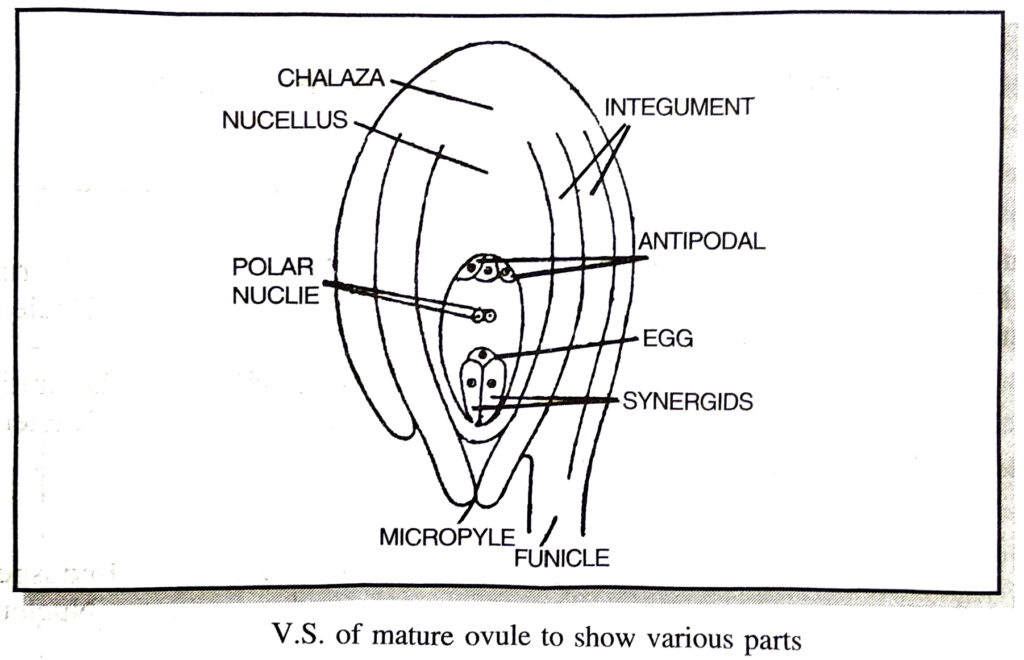
Q. 30. Give the structure of pollen grain.
Ans. Structure of Pollen Grain.
Pollen grain is a microscopic unicellular structure. It is covered by two layered walls-the inner intine and the outer thick exine. At certain places the exine has pores called germ pores. It contains two nuclei – a generative nucleus and a tube nucleus.
Q. 31. Trace the steps involved in the formation of the plant seed from pollination.
Or
Explain sexual reproduction in flowering plants.
Ans. Formation of plant seed
1. Pollination is transfer and deposition of pollen on stigma.
2. Pollen grain germinates on the stigma. It gives rise to pollen tube which carries male gametes.
3. A hypodermal cell of the nucellus in ovule enlarges and form megaspore mother cell.
4. The diploid megaspore mother cell undergoes meiosis to form four megaspores.
5. The functional megaspore enlarges into embryo sac.
6. The process of nuclear fusion (syngamy) of the male nucleus and one egg nucleus is termed fertilization. It forms diploid zygote. Second male gamete fuses with secondary nucleus to form primary endosperm nucleus.
7. Angiosperms exhibit double fertilization.
8. Fall of the petals, stamens, style and stigma.
9. The ovules develop into seeds.
10. As seeds contain the miniature but dormant future plant, they are dispersed by various agents such as wind, water and animals.
Q. 32. Depict the events of fertilization.
Ans.
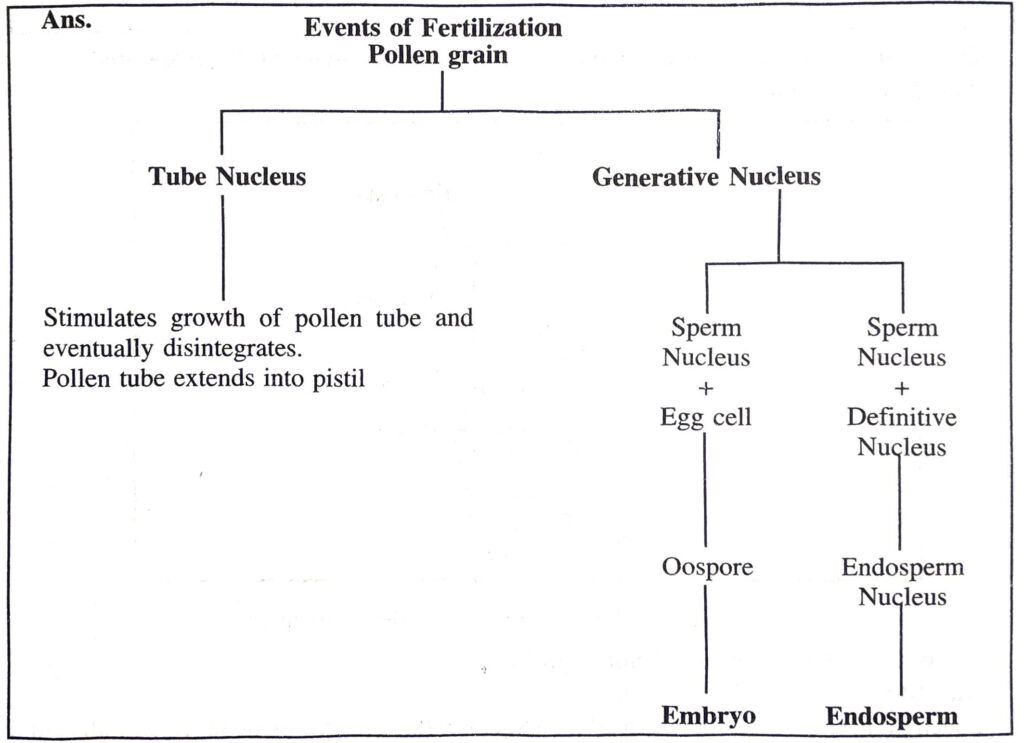
Q. 33. With the help of a labelled diagram, describe double fertilisation in plants.
Ans. Double fertilization in plants.
1. The process of double fertilization occurs inside each embryo sac in which two fusions i.e. syngamy and triple fusion take place.
2. As the pollen tube enters the ovule, the pollen tube releases two male gametes into embryo sac.
3. The embryo sac contains the egg.
4. The fusion of male and female gametes in the embryo sac of ovule is called syngamy. The product is called zygote.
5. The other male gamete fuses with the two polar nuclei. It is called triple fusion.
Significance. (i) Double fertilization provides stimulus to endosperm mother cell for the formation of nutritive tissue named endosperm. (ii) It ensures continued supply of nourishment to the embryo that develops from zygote.
Q. 34. Draw diagram to show the path of pollen tube into pistil during fertilization.
Ans. Path of Pollen tube into pistil during fertilization.
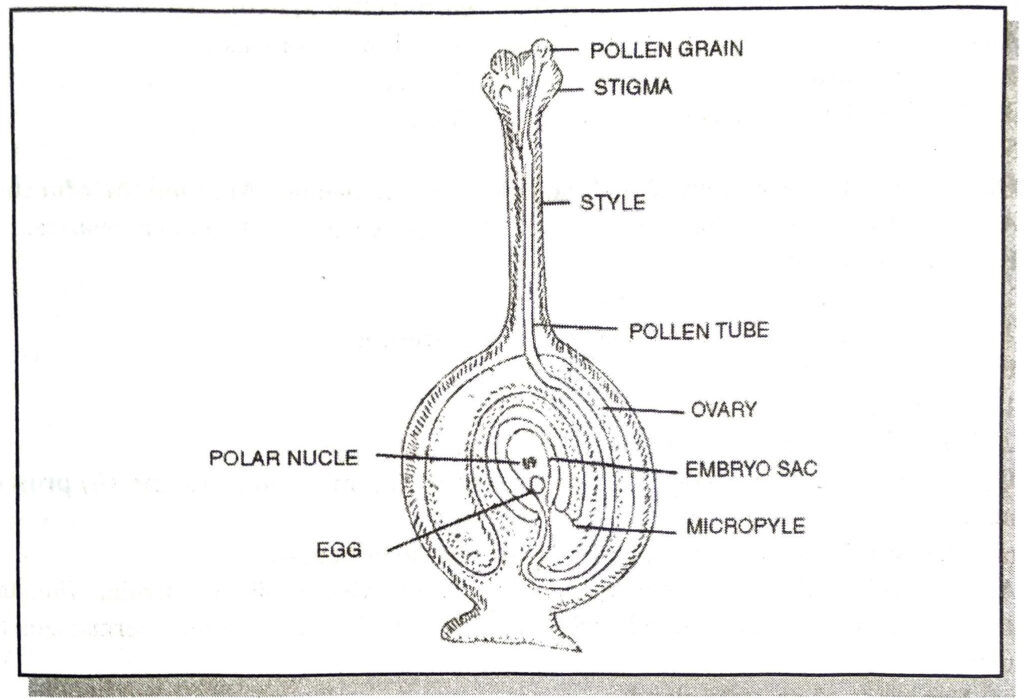
Q. 35. Explain post-fertilization changes in plants.
Ans. Post-fertilization changes. After fertilization most of the parts of the flower wither and significant changes occur inside the ovary.
1. The fertilized egg or zygote (oospore) along with the ovule changes into the seed.
2. The wall of the ovule forms the seed coat (testa). The seed contains the potential plant or embryo.
3. The embryo consists of radicle (potential root), plumule (potential shoot) and cotyledons (seed leaves).
4. In dicotyledonous plants there are two cotyledons while in monocotyledonous plants there is one cotyledon.
5. In monocotyledonous plants food is stored in the endosperm (part of the seed).
6. The seeds become dry and dormant to overcome adverse conditions.
7. Ultimately the wall of the ovary ripens and changes into a fruit. Thus we see the seeds inside the fruit.
Q. 36. Name the various organs of male reproductive system of man.
Ans. Male reproductive organs of man.
1. A pair of testis
2. A pair of epididymis
3. A pair of vasa deferentia
4. Urethra
5. Penis. A pair of seminal vesicles.
6. Male reproductive glands, Cowper’s gland and prostate gland.
Q. 37. Name the various organs of female reproductive system.
Ans. Female reproductive system is composed of following organs :
1. A pair of ovaries.
2. Vagina
3. A pair of fallopian tubes.
4. Vulva
5. Uterus.
Q. 38. What are the male and female gonads in human beings ? Mention their function.
Ans. Male Gonads. The male gonads are called testes and female gonads ovaries. Functions of testes :
1. Testes produce male gametes called sperms.
2. Testes produce male sex hormone called testosterone.
Functions of ovary :
1. Formation of female gametes (ova).
2. Production of female sex hormones (Estrogen and progesterone).
Q. 39. (a) In the human body what is the role of (i) seminal vesicles and (ii) prostate gland ?
(b) List two functions performed by testes in human beings.
Ans. (a) (i) Function of seminal vesicles. They secrete viscous alkaline seminal fluid that contains sugar fructose and ascorbic acid. Fructose provide energy to the spermatozoa for swimming.
(ii) Functions of prostate gland
1. It secretes the milky white slightly acidic fluid.
2. The secretion nourishes and serves as the medium for spermatozoa.
(b) Functions of testes :
1. Formation of female gametes (ova).
2. Production of female sex hormones (Estrogen and progesterone).
Q. 40. Write names of one male and one female sex hormones.
Ans. Males sex hormone. Testosterone.
Female sex hormone. Estrogen.
Q. 41. What is significance of the Leydig cells ?
Ans. Leydig’s cells are the interstitial cells which secrete the male sex hormones, testosterone. Testosterone hormone helps in the development and maintenance of the primary and secondary sexual characteristics and the formation of spermatozoa.
Q. 42. Briefly explain the process of ovulation.
Ans. Under the influence of follicular stimulating hormone (FSH) of the pituitary, the ovarian follicle develops. Inside the ovarian follicle which is also known as a Graafian follicle a matured ovum is present. Under the influence of FSH and LH (Luteinizing hormone), the matured ovum is released by the Graafian follicle. This process of release of ovum is called ovulation.
Q. 43. Define Menstruation, precocious puberty and menopause.
Ans. Menstruation. It is a process in which the blood, mucus and uterine tissue eliminated in female mammals.
Precocious puberty. Normally a woman’s fertile life starts from the age of puberty (about 13 years), but under some abnormal conditions like high level of sex hormones (LH and FSH), menstruation starts at an early age than the normal, and then it is called precocious puberty.
Menopause. The natural physiological stoppage of menstruation is called menopause or the arrest of reproductive capacity at the age of 45-50 is called menopause. Woman is unable to bear the children.
Q. 44. Name and define the four stages in the uterine cycle.
Ans. Uterine Cycle. The uterine cycle consists of four distinct stages as follows:
1. Menstruation. It lasts for five days.
2. The proliferative phase. From the end of menstruation to the release of ovum, it lasts for 10-14 days.
3. Ovulatory phase. It is the release of ovum from the ovary.
4. Luteal. It lasts from ovulation to menstruation for about 10-days.
Q. 45. Write a short note on child birth or parturition.
Ans. 1. At or about the 40th weeks of pregnancy labour sets in. Contraction of the muscles of the uterine wall starts in the early stages of labour. This results in severe pain to the mother. It is known as labour pain.
2. The contraction of the uterine wall brings the baby towards the mouth of the uterus.
3. The extra embryonic layer, amnion bursts at this time which lubricates the vagina and also creates a sort of pressure by which outward progression of the foetus is facilitated. more flexible.
4. The joint of the pelvic bones becomes
5. The cervix and the vaginal passage becomes much more flexible and wider.
6. At the same time, the uterine contractions become more and more forceful due to which the baby is forced out more and more.
7. Finally, it comes out completely. Generally the head comes out first followed by the shoulders, then the body and finally the legs.
8. The hormone relaxin plays an important role in the relaxation and expansion of the uterus and the vagina.
Q. 46. What is placenta ?
Ans. Placenta. It is the structure formed by the union of the foetal and uterine tissue for the purpose of nutrition, respiration and excretion of the embryo. Although the blood vessels of the embryo and the mother come close but these are kept separated by some barriers between them. The useful substances pass from maternal blood to foetal blood while the wastes (excretory products and CO₂) are passed from the foetal blood to maternal blood.
Q. 47. Write the functions of placenta.
Ans. Functions of placenta. The placenta serves primarily as an organ that permits the interchange of materials carried in the blood of mother and foetus. The main functions are:
1. Nutrition. Supply of nutrient materials to foetus.
2. Respiration. Supply of O₂ to foetus and receive CO₂ back from it.
3. Excretion. Fluid nitrogenous waste products escape through the placenta.
4. Barrier. The placenta is barrier like semipermeable membrane.
5. Storage. The placenta stores fat, glycogen and iron for the embryo before the formation of liver.
6. Hormonal function. The placenta secures extra ovarian hormones estrogen and progesterone in female during pregnancy that serves to maintain foetus.
Q. 48. What is artificial insemination ? Write the uses of artificial insemination.
Ans. Artificial insemination. A process by which spermatozoa are collected from male and deposited in the female genitalia by instrumentation rather than by natural service is called artificial insemination.
Uses of artificial insemination.
1. The semen of good quality of male animal may be used to inseminate number of females.
2. The preserved spermatic fluid can be transported to different places.
3. In case of man who is incapable of producing children this method can be used.
Q. 49. Name one sexually transmitted disease each caused due to bacterial infection and viral infection. How can these be prevented ?
Ans. Sexually transmitted disease caused due to bacterial infection: Syphilis. Sexually transmitted disease caused due to viral infection : AIDS.
Prevention of sexually transmitted disease
(i) People, particularly those in high-risk group, should be educated about AIDS transmission, advantage of using condom, danger of sharing needles and virtue of monogamy. Adultery has been prohibited in all religions. It must be avoided.
(ii) Sexual habits should be changed.
(iii) Before receiving blood, it should be screened for HIV.
Q. 50. What is puberty ? Name the hormones responsible for production of sexual characters in human beings.
Ans. Puberty. The period at which reproductive organs become mature and capable of functioning.
(i) Changes in female (girl) at the time puberty. These changes occur under the influence of hormones FSH (Follicle stimulating hormone) and estrogen.
1. Growth of breast and external genitalia.
2. Darkening of nipple skin.
3. Broadening of pelvis.
4. Growth of pubic and axillary hair.
5. Increase in subcutaneous fat.
6. Initiation of menstruation and ovulation.
(ii) Changes in male (boy). In male testosterone hormone is responsible for puberty.
1. Change of voice.
2. Appearance of beard and moustaches.
3. Discharge of semen.
Q. 51. How will an organism be benefited if it reproduces through spores ?
Ans. Benefit of spore formation : 1. Spores help to take over unfavourable condition.
2. Spores are produced in large numbers and they help in multiplication.
3. Spores are tiny thick-walled and carried by wind to far off places thus help in despersal.
Q. 52. Define reproductive health. What happens when the egg is not fertilized ?
Ans. Reproductive health. It refers to the complete state of physical mental and social well being of and not merely absence of disease or infirmity in all matter related to reproductive system and its functions and process.
If the egg is not fertilized the egg do not get implanted and endometrium breaks down. Thus the broken endometrium along with unfertilized egg, blood from broken capillaries flows out as menstrual flow. It is termed menstruation. The cycle changes occur every 28 days in the reproductive tract of human female from the period of puberty to age of menopause is called menstrual cycle.
VERY SHORT ANSWER TYPE QUESTIONS
Q. 1. What is reproduction ?
Ans. Reproduction. It is the ability of an organism to produce the young ones of its own kind.
Q. 2. What is the role of reproduction ?
Ans. (i) Propagation of species
(ii) Evolution of species.
Q. 3. Name the two major kinds of reproduction.
Ans. Asexual and sexual reproduction.
Q. 4. Name the molecules which makes its copy before reproduction.
Ans. DNA.
Q. 5. Expand DNA.
Ans. DNA. Deoxyribose nucleic acid.
Q. 6. What is basis for evolution ?
Ans. The inbuilt capacity for variations during reproduction.
Q. 7. List the common methods of asexual reproduction.
Ans. (1) Binary fission (2) Multiple fission (3) Spore formation (4) Budding (5) Regeneration (6) Vegetative propagation.
Q. 8. Name the various methods of vegetative propagation in plants.
Ans. (1) Cutting (2) Layering (3) Grafting.
Q. 9. Give two examples of each. Vegetative propagation by (i) tissue culture (ii) Layering.
Ans. (i) Tissue Culture – Orchid, Asparagus. -dendron.
(ii) Layering Magnolia, Rhodo-
Q. 10. Which part of bryophyllum can be used for vegetative propagation ?
Ans. Leaf of Bryophyllum.
Q. 11. Give one example of each: Vegetative propagation by (i) root (ii) stem.
Ans. (i) Vegetative propagation by roots e.g. Sweet potato.
(ii) Vegetative propagation by stem e.g. Potato.
Q. 12. (i) When does binary fission and multiple fission in amoeba take place ? (ii) ‘Malarial parasite’ divides into many daughter individuals simultaneously through multiple fission. State an advantage the parasite gets because of this type of reproduction.
Ans. (i) Binary fission takes place during favourable period and multiple fission occurs during unfavourable period in amoeba.
(ii) Multiplication i.e. increase in number.
Q. 13. How do yeast, sponges and hydra reproduce asexually ?
Ans. All the three reproduce by budding.
Q. 14. How do Spirogyra and Mucor reproduce asexually ?
Ans. Spirogyra. Fragmentation and Regeneration. Mucor. Spore formation.
Q. 15. What is fruit ?
Ans. Fruit. Fruit is ripened ovary.
Q. 16. Which parts of the seed form root and shoot?
Ans. 1. Root is formed from radicle. 2. Shoot is formed from plumule.
Q. 17. Name the male and female gametes of man.
Ans. Male gamete-Sperm; Female gamete- Ovum.
Q. 18. What is after birth?
Ans. Placenta expelled after delivery.
Q. 19. Fertilization is fusion of sperm and Ovum (True/False)
Ans. True.
Q. 20. Where does fertilization take place in human beings ?
Ans. In the fallopian tube.
Q. 21. Duration of menstrual cycle in human female is 20 days. (True/False)
Ans. False.
Q. 22. In how many weeks development of foetus is completed ?
Ans. About 40 (forty) weeks after fertilization.
Q. 23. Give one example of each. (i) mechanical methods of contraception (ii) chemical methods of contraception.
Ans. Mechanical. Condoms in males and diaphragm in female.
Chemical. Use of oral pills.
Q. 24. What is the removal of small piece of sperm duct from male and fallopian tube from female called?
Ans. Removal of sperm duct-Vasectomy
Removal of fallopian tube-Tubectomy.
Q. 25. When do the boys attain adolescence ?
Ans. 16 to 18 years.
Q. 26. When do the girls attain adolescence ?
Ans. 13 to 15 years.
Q. 27. Name the part of female genital tract where foetus develops.
Ans. Uterus.
Q. 28. What is the function of copper-T?
Ans. A copper-T is placed safely inside the uterus. It prevents implantation in the uterus.
Q. 29. List the aspects which reproductive health includes.
Ans. Reproduction health includes aspects that ensure a responsible, safe and satisfying reproductive life.
Q. 30. Name any three sexually transmitted diseases (STDs).
Ans. Gonorrhoea, Syphilis and AIDS.
Q. 31. Name any two sexually transmitted diseases.
Ans. 1. AIDS 2. Syphilis.
Q. 32. Expand HIV, IUCD and OC.
Ans. HIV – Human Immunodeficiency Virus
IUCD – Intra Uterine Contraceptive Device
OC – Oral Contraceptive
MULTIPLE CHOICE QUESTIONS
Select the correct answer out of the four alternatives :
1. In the list of organisms given below, those that reproduce by the asexual method are :
(i) banana (ii) dog (iii) yeast (iv) Amoeba.
(A) (ii) and (iv)
(B) (i) (iii) and (iv)
(C) (i) and (iv)
(D) (ii), (iii) and (iv).
Ans. (B) (i) (iii) and (iv)
2. Which of the following parts of flowers shrivel and fall off after fertilization ?
(A) Sepals
(B) Petals
(C) Stamens and carpel
(D) All of above.
Ans. (A) Sepals
3. Which of the following parts of a seed forms a new plant ?
(A) Endosperm
(B) Seed coat
(C) Embryo
(D) Radicle.
Ans. (C) Embryo
4. The correct sequence of reproductive stages seen in flowering plants is :
(A) gametes, zygote, embryo, seedling
(B) zygote, gametes, embryo, seedling
(C) seedling, embryo, zygote, gametes
(D) gametes, embryo, zygote, seedling.
Ans. (A) gametes, zygote, embryo, seedling
5. The testes in male human produce :
(A) Egg
(B) Sperms
(C) Both eggs and sperms
(D) None of above.
Ans. (B) Sperms
6. The ability of an organism to grow or replace the lost part of body is known as:
(A) grafting
(B) regeneration
(C) layering
(D) budding.
Ans. (B) regeneration
7. Which of the following parts of Bryophyllum plant is vegetative ?
(A) Leaves
(B) Root
(C) Stem
(D) Flower.
Ans. (A) Leaves
8. The important parts of flower are :
(A) Sepals and petals
(B) Sepals and stamens
(C) Petals and carpels
(D) Stamens and carples.
Ans. (D) Stamens and carples.
9. The special tissue by which embryo gets nutrition through mother’s blood is :
(A) Amnion
(B) Chorion
(C) Placenta
(D) Zygote.
Ans. (C) Placenta
10. Which of the following reproduce by budding ?
(A) Amoeba
(B) Paramecium
(C) Earthwarm
(D) Hydra.
Ans. (D) Hydra.
11. Regeneration occurs in:
(A) Planaria
(B) Spirogyra
(C) Hydra
(D) All of above.
Ans. (D) All of above.
12. Yeast reproduces by :
(A) Binary fission
(B) Budding
(C) Fragmentation
(D) Sexually
Ans. (B) Budding
13. The female germ cell which lie in ………… of the flower:
(A) Ovary
(B) Sepal
(C) Petal
(D) Stamen.
Ans. (A) Ovary
14. The part of flower which changes into fruit is :
(A) Stigma
(B) Ovule
(C) Ovary
(D) Anther.
Ans. (C) Ovary
15. Which of the following part of female reproductive system produce eggs?
(A) Ovary
(B) Uterus
(C) Fallopian tube
(D) Vas deferens
Ans. (A) Ovary
16. Fertilization occurs in :
(A) ovary
(B) uterus
(C) fallopian tube
(D) vagina.
Ans. (B) uterus
17. Spirogyra can reproduce by :
(A) fission
(B) vegetative propagation
(C) fragmentation
(D) regeneration.
Ans. (C) fragmentation
18. The Germ cells are specialized for :
(A) Vegetative propagation
(B) Fighting infection
(C) Asexual reproduction.
(D) Sexual reproduction.
Ans. (D) Sexual reproduction.
19. The embryo gets nutrition from the mother’s blood with the help of a special tissue called:
(A) Placenta
(B) Villi
(C) Ovary
(D) None of these.
Ans. (A) Placenta
20. The terminal sticky part of carpel is:
(A) Stigma
(B) Style
(C) Stamen
(D) Pollen tube.
Ans. (A) Stigma
21. Binary fission is common method of reproduction in :
(A) Plasmodium
(B) Amoeba
(C) Hydra
(D) Bryophyllum.
Ans. (B) Amoeba
22. Pollen grains are produced by :
(A) Carpel
(B) Stamen
(C) Stigma
(D) Petal.
Ans. (B) Stamen
23. Which of the following types of reproduction is found in Leishmania ?
(A) Multiple fission
(B) Binary
(C) Budding wake
(D) Spore formation
Ans. (B) Binary
24. Seed is formed from the :
(A) Ovary
(B) Ovule
(C) Pollen tube
(D) Sepal.
Ans. (B) Ovule
25. Which of the following organism reproduce by budding?
(A) Hydra
(B) Planaria
(C) Amoeba
(D) Plasmodium.
Ans. (A) Hydra
26. The part of flower which change into fruit is :
(A) Stigma
(B) Ovule
(C) Ovary
(D) Anther.
Ans. (C) Ovary
27. Which of the following part of seed form a new plant ?
(A) Endosperm
(B) Seed coat
(C) Radical
(D) Embryo.
Ans. (D) Embryo.
28. Which of the following parts of flower shrivel and fall off after fertilization ?
(A) Sepals
(B) Petals
(C) Stamen and carpels
(D) All of these.
Ans. (A) Sepals
29. Which of the following part of Bryophyllum in plants is used in vegetative reproduction ?
(A) Leaves
(B) Stem
(C) Root
(D) Flower.
Ans. (A) Leaves
30. The asexual reproduction takes place through budding in :
(A) Amoeba
(B) Yeast
(C) Plasmodium
(D) Hydra.
Ans. (D) Hydra.
31. The first step in sexual reproduction at the cellular level is :
(A) Formation of special sex cells
(B) Cell division
(C) DNA copying
(D) Elongation of cells.
Ans. (D) Elongation of cells.
32. The emboryo gets nutrition from mother’s blood with the help of special tissue called :
(A) Placenta
(B) Oviduct
(C) Uterus
(D) Ovary.
Ans. (A) Placenta
33. Testes secrete on hormone called :
(A) Progesterone
(B) Testosterone
(C) Auxin
(D) None of above.
Ans. (B) Testosterone
34. The fertilized egg, the zygote, gets implanted in the lining of :
(A) Uterus
(B) Ovary
(C) Vas deferens
(D) Fallopian tube.
Ans. (A) Uterus
Follow on Facebook page – Click Here
Google News join in – Click Here
Read More Asia News – Click Here
Read More Sports News – Click Here
Read More Crypto News – Click Here